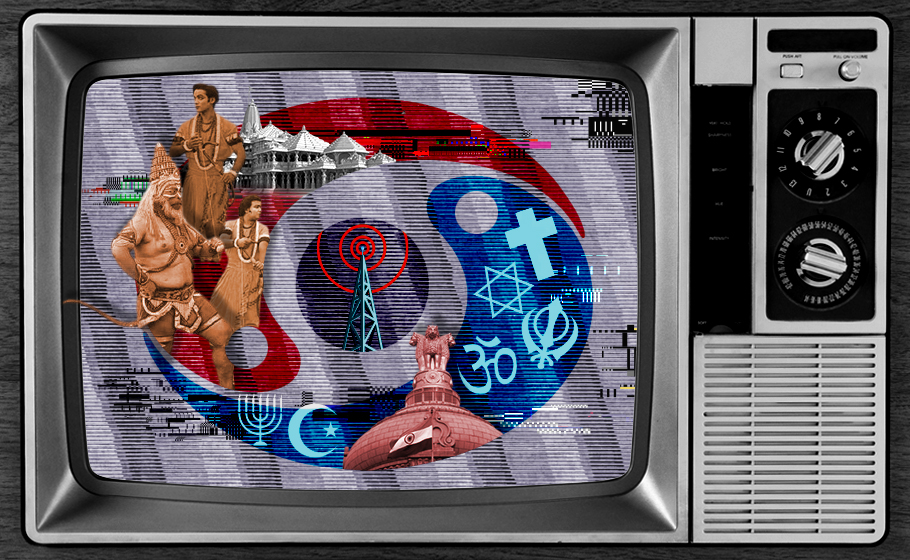
DD's Ramlila telecast: Evolving plot and a script hidden in plain sight?
The National broadcaster, Doordarshan, has started the telecast of ‘Ramlila’ [same as Ram Leela] event live from Ayodhya amid a lot of opposition and discussion on whether the national, public service broadcaster should cover an event of a particular religion.

The National broadcaster, Doordarshan, has started the telecast of ‘Ramlila’ [same as Ram Leela] event live from Ayodhya amid a lot of opposition and discussion on whether the national, public service broadcaster should cover an event of a particular religion. (The Ramlila events enact the life of the mythical Lord Ram).
The views are divergent as one section argues that there is nothing wrong in the channel broadcasting an event which has been happening for many decades (The iconic Delhi Ramlila event has been there for 80 years). The others think the secular ethos of the country is stumped when a public service broadcaster chooses to extensively cover the event of one religion, especially when it has a deep ringing with the ruling dispensation of the county.
Opposition
Ther Left parties were the ones to first come out against the move, alleging a hidden agenda and a secret plot to usurp a national media for political gains.
CPI parliamentary party leader Binoy Viswam, MP, in a letter to Union Minister for Information and Broadcasting Prakah Javadekar, said the use of Doordarshan to broadcast the religious function at Ayodhya is contrary to the accepted norms of national integrity.
Also read: No more bragging, 90s kids! DD brings back 80s classics amid lockdown
He said in the letter that the demolition of the Babri Masjid in 1992 and the subsequent mobilization around the Ram Janbhoomi Temple in Ayodhya ‘has been a source of conflict and disharmony in the country for decades now.’
Former Prasar Bharati CEO Jawahar Sircar wrote in an article on Indian Express on August 2 that Doordarshan could have been chosen for its ‘proven multi-camera skills.’ Elaborating, he said, the agency coordinates live feed from over 50 cameras on Republic Day.
He goes on to add though: “Doordarshan moved on to eulogising whichever government came to power and the paymaster decided what better subjects to cover,” in an apparent explanatory on why the broadcaster covers such religious events.
Sircar says the benefits of the 78-episode Ramayana (the telecast of which concluded on July 31, 1988) and the 94-episode Mahabharata (started on October 2, 1988) was reaped by L.K. Advani who chose the mofussil town of Ayodhya to launch a political campaign. And, the writer points out that after Advani’s 1989 ‘shilanyas,’ the tally of the BJP rose to 85 in Lok Sabha from an insignificant two in the previous election of 1984.
Also read: Rambhakts to memebhakts: Millenial version of 90s Ramayan nostalgia
Scholars like Christophe Jaffrelot had taken a keen interest in the way the narrative was being directed on this front. In a paper in 2008, titled, ‘Hindu Nationalism and the (Not So Easy) Art of Being Outraged: The Ram Setu Controversy,’ Dr. Jaffrelot says, “Outrage to the sacred is usually instrumentalised by ethno-political entrepreneurs from the BJP and the VHP who attempt to mobilize — and gain followers — for a crucial cause.”
The Prasar Bharati Act
The Prasar Bharati, set up under the The Prasar Bharati (Broadcasting Corporation of India) Act, 1990, lists ‘upholding the unity and integrity of the country and the values enshrined in the constitution as its first function (12.1).
The Centre is empowered to give the corporation (Prasar Bharati) directions under Chapter IV of the Act. Serial number 23.1 of the Act states that the Centre can issue such directions as it may think necessary ‘in the interests of the sovereignty, unity and integrity of India or the security of the State or preservation of public order requiring it not to make a broadcast on a matter specified in the direction or to make a broadcast on any matter of public importance specified in the direction.
Also read: Delhi’s mega Ramlila event unlikely to be held this year
However, the corporation holds with it a unique right — the right to announce that a broadcast has been made in pursuance of such a directive, if it wishes so. Probably, this would be the one clause that is observed more in its ‘non-observance.’
Details of the coverage
A media release issued by the Uttar Pradesh Department of Information said state Tourism, Culture, and Religious Affairs Minister Neelkanth Tiwari and Bharatiya Janata Party MP Pravesh Sahib Singh Verma ‘launched’ the live-streaming, as per a report on LiveMint.
The Ramlila will be performed for nine days of Navratri from October 17 to October 25.
Earlier, in October, the Centre had decided to cancel the mega Ramlila event in Delhi’s iconic Red Fort due to the ongoing pandemic.
The Luv Kush Ramleela Committee, the organisers of the event, were not very happy about the cancellation. Arjun Kumar, Head of Luv Kush Ramleela Committee, had said that the restrictions were restraining them and the ‘government’s intent is that the event should not take place.’
For once, the Delhi government and the Centre seemed to be on the same page when state Chief Minister Arvind Kejriwal and Union Health Minister Harsh Vardhan voiced concerns about any large gathering.
Shashi S Vempati, CEO of Prasar Bharati, tweeted about the telecast along with photos of arrangements being done by the Doordarshan crew.
“Team Doordarshan all set to bring Ram Leela from Ayodhya LIVE starting today,” he said in the tweet.

